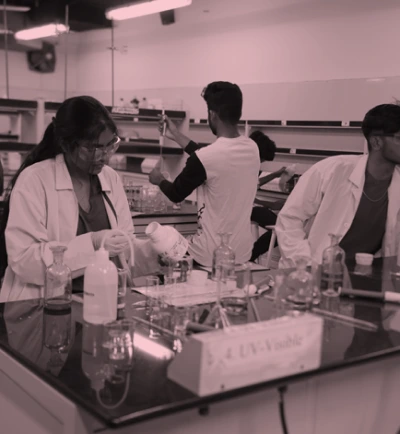
Pijus Kanti Barman
Assistant Professor
pijus.barman@mahindrauniversity.edu.in
Pijus K. Barman earned his Ph.D. in Immunology from the Institute of Life Sciences, Bhubaneswar, India. During his doctoral research in the laboratory of Prof. B. Ravindran he studied the regulation of inflammatory responses during tissue injury and infection. His first postdoctoral training in Prof. Timothy Koh’s lab at the University of Illinois at Chicago was focused on studying monocyte production (monopoiesis) during normal and diabetic wound healing. He then moved to Prof. Helen Goodridge’s lab at Cedars-Sinai Medical Center, in Los Angeles where he explored how aging impacts monocyte ontogeny and phenotype. Dr. Barman has joined the Center for Life Sciences, Mahindra University, in September 2022 as an Assistant Professor.
B.Sc
- B.Sc (2003-2006); University of Calcutta, Calcutta, West Bengal, India
M.Sc
- M.Sc (2006-2008); Guru Nanak Dev University, Amritsar, Punjab, India
Ph.D
- Ph.D (2009-2016); Institute of Life Sciences, Bhubaneswar, Odisha, India
2022- Present
- 2022- Present Assistant Professor Center for Life Sciences Mahindra University.
2019 - 2022
- Postdoctoral Research Scientist (2019-2022); Cedars-Sinai Medical Center, Los Angeles, California, USA
- Project Scientist (2022); Cedars-Sinai Medical Center, Los Angeles, California, USA
2016 - 2019
- Postdoctoral Research Associate (2016-2019); University of Illinois at Chicago, Chicago, Illinois, USA
2024
- Kang S, Andrews AE, Ko EY, Shin JE, Nance KJ, Barman PK, Heeger PS, Benayoun BA, Goodridge HS. C3a drives sex-dimorphic metabolic and transcriptional rewiring of microglia during aging. Journal of Neuroinflammation. 2024 Jun 05; 21, 150.
2022
- Barman PK,Shin JE, Lewis SA, Kang S, Wu D., Wang Y, Yang X, Nagarkatti PS, Nagarkatti M, Messaoudi I, Benayoun BA, Goodridge HS. Production of MHCII-expressing classical monocytes increases during aging in mice and humans. Aging Cell. 2022 Aug 30; 00:e13701.
- Barman PK, Goodridge HS. Microbial sensing by hematopoietic stem and progenitor cells. Stem Cells, 2022 Jan 19; 40, 14–21.
2020
- Barman PK,and Koh TJ. Macrophage Dysregulation and Impaired Skin Wound Healing in Diabetes. Front Cell Dev Biol, 2020 Jun 26; 8, 528.
2019
- Barman PK, Urao N, and Koh TJ. Diabetes induces myeloid bias in bone marrow progenitors associated with enhanced wound macrophage accumulation and impaired healing. J Pathol, 2019 Jul 18; 249, 435-446.
- Wolf AA, Yanez A, Barman PK,and Goodridge HS. The Ontogeny of Monocyte Subsets. Front Immunol, 2019 Jul 17; 10, 1642.
- Barman PK, Pang J, Urao N, and Koh TJ. Skin Wounding-Induced Monocyte Expansion in Mice Is Not Abrogated by IL-1 Receptor 1 Deficiency. J Immunol, 2019 March 25; 202, 2720-2727. (Featured in “In this issue - Skin Wounding Sparks Monocytes”).
2018
- Fang MM, Barman PK,Thiruppathi M, Mirza RE, McKinney RD, Deng J, Christman JW, Du X, Fukai T, Ennis WJ, et al. Oxidant Signaling Mediated by Nox2 in Neutrophils Promotes Regenerative Myelopoiesis and Tissue Recovery following Ischemic Damage. J Immunol, 2018- Sep 18; 201, 2414-2426.
2016
- Barman PK,Mukherjee R, Prusty BK, Suklabaidya S, Senapati S, and Ravindran B. Chitohexaose protects against acetaminophen-induced hepatotoxicity in mice. Cell Death Dis, 2016 Jul 4; 7, e2224.
2015
- Mukherjee R, Barman PK,Thatoi PK, Tripathy R, Das BK, and Ravindran B. (2015). Non-Classical monocytes display inflammatory features: Validation in Sepsis and Systemic Lupus Erythematous. Sci Rep, 2015 Sep 11; 5, 13886.
2009
- Pandey M, Borah A, Varghese M, Barman PK, Mohanakumar KP, and Usha R. Striatal dopamine level contributes to hydroxyl radical generation and subsequent neurodegeneration in the striatum in 3-nitropropionic acid-induced Huntington's disease in rats. Neurochem Int, 2009 May 3; 55, 431-437.
Book Chapter
2020
- Barman, P.K., Koh, T.J.Bone marrow monopoiesis and wound healing in diabetes. Academic Press, 2020, 535-553. Wound Healing, Tissue Repair, and Regeneration in Diabetes.
Monocytes and Infectious Diseases
Human and animal communities residing in infectious disease endemic regions can be classified into three categories; (i) “symptomatic carriers”, who develop infections with pathologies and hence are susceptible to the infections, (ii) “asymptomatic carriers”, who are infected but without any pathology and hence are tolerant to the infections and (iii) “uninfected”, who are exposed to the pathogens but are not infected and hence are resistant to the infections. We are interested in studying the role of monocyte subsets in “susceptibility versus resistance versus tolerance” against infectious pathogens using mouse models of infectious diseases and human patients.
Bone Marrow Microenvironment and Hematopoiesis
Hematopoietic stem cells (HSCs) reside in bone marrow niche which contains various components including mesenchymal stromal cells (MSCs) and sympathetic nerves. Increased β2-adrenergic receptor signaling from sympathetic nerves to MSCs is believed to alter HSCs in turn to produce more myeloid cells during aging and metabolic stress. We are interested in defining the mechanisms involved in increased β2-adrenergic receptor signaling in the bone marrow during aging and metabolic stress using in vitro cell cultures and mouse models.
Aging and Cardiovascular diseases
Aging leads to higher risk of cardiovascular diseases such as atherosclerosis by yet unknown mechanism. Various immune cells including monocytes play important roles in the formation of atherosclerotic plaque in blood vessels ultimately causing obstruction of blood flow and necrosis of downstream tissues. In our laboratory, we are investigating the mechanism underlying functionally altered monocytes in higher risk of atherosclerosis during aging.









